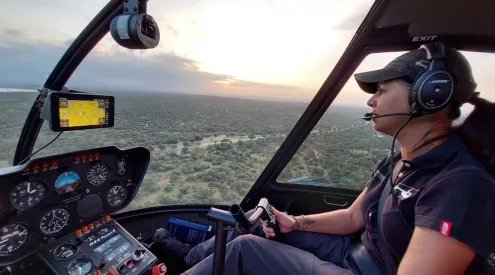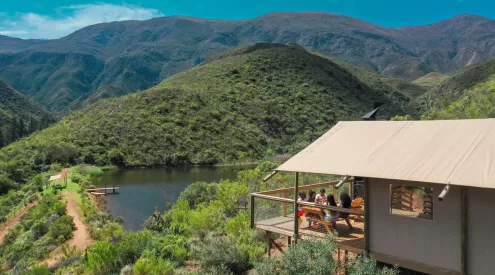In January over 2 ,000 balls of fluff wobbled their way into the news: lesser flamingo chicks, scooped from nests left exposed by the receding waters of Kamfers Dam in Kimberley. Drought and issues with sewage treatment and lack of waste-water effluent were to blame. Although the jury’s out on whether the rescues were essential, suddenly there were 2, 000 mouths to feed.

The flamingo island in Kamfers Dam measures 250m x 25m. Nesting season is from October to February.
That the babies even exist is remarkable. Kamfers is one of only four regular African breeding sites for the pink wonders – and the newest. A plan to get the birds to nest here was conceived in 2006 by Mark Anderson, now CEO of BirdLife SA. An S-shaped island – safe from predators and disturbance – was bulldozed into being with the help of local mining company Ekapa. It was covered in sticky clay for nest building, and fake turrets were erected to plant the idea in the birds’ brains. The results were spectacular: more than 24,000 chicks were raised from 2008 to 2011. The southern African population was estimated at 65,000.
Since then, the Kamfers flamingos have been besieged by avian pox, floods and too much raw sewage, although a R100-million infrastructure repair job later helped. Until January this year… Volunteers took on the arduous task of feeding the rescued chicks every four hours. Kimberley vet Donovan Smith was one of many who fed the infants a mixture that included Nestum baby food and Beefee vitamin powder, drop by drop from a syringe. Donovan grew fond of No. 18 (a tough bully called Steven) and another dehydrated scrap wounded by crows. ‘We thought it couldn’t survive, but somehow it kept going, so we gave it the number 0 and called him Zorro. That changed to Xena when we realised she was female.’
Dr Doug Harebottle, head of biological and agricultural sciences at Sol Plaatje University, says that about one in three of the rescued chicks made it to release: poignant videos show groups of survivors flapping their way to the shoreline. But that’s not the end of the story. The juveniles have been ringed, and 20 are fitted with natty GPS trackers weighing just 18g. Solar powered, these collect info hourly and send it back to scientists every eight hours. Vital information on behaviour and dispersion is trickling in: ringed birds have made it to Namibia, Mpumalanga and Port Elizabeth. ‘We’re learning about routes never recorded before,’ says Harebottle.
There have been inevitable losses – and new dangers discovered, like collisions with nearby Transnet railway lines. Moves are afoot to fund the replacement of the dilapidated old bird- scaring devices, or ‘flappers’, on the lines, and these will have LED lights to help birds avoid the lines when flying at night. Sol Plaatje Municipality says it’s committed to supplying effluent to Kamfers, and a new pipeline completed in July should help. Sometimes, individuals really do make a difference. cfoo.co.za/flamingo/info.html
*This article was originally written in September 2019. Since then, it appears that the waste water problems plaguing the dam have not been fully resolved. There has also been some controversy about a number of rescued chicks who have not yet been released. Keep up with the latest on these issues via the Save the Flamingo Facebook group. Good news is that many flamingoes are currently at Kamfers dam. While some signs of courtship have been observed, breeding has not been confirmed.
How To Help
Think Pink
– Seen a flamingo with a yellow ring? Send the details to [email protected] to help keep track of the youngsters.
– BirdLife is raising funds for new flappers and other projects; see birdlife.org.za.
– Join the Facebook group Save the Flamingo to for ideas on how to help.
Field notes by Janine Stephen


















